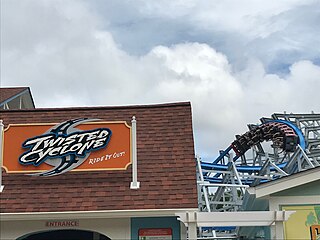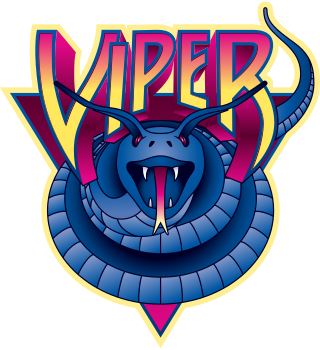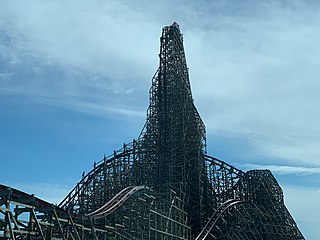
A wooden roller coaster is a type of roller coaster classified by its wooden track, which consists of running rails made of flat steel strips mounted on laminated wood. The support structure is also typically made of wood, but may also be made of steel lattice or truss, which has no bearing on a wooden coaster's classification. The type of wood often selected in the construction of wooden coasters worldwide is southern yellow pine, which grows abundantly in the southern United States, due to its density and adherence to different forms of pressure treatment.
A steel roller coaster is a type of roller coaster classified by its steel track, which consists of long steel tubes that are run in pairs, supported by larger steel columns or beams. Trains running along the track typically rely on wheels made of polyurethane or nylon to keep each train car anchored to the track. The introduction of tubular steel drastically changed roller coaster innovation, allowing for greater speeds, higher drops, and more intense elements such as inversions.

Six Flags Magic Mountain, formerly known and colloquially referred to as simply Magic Mountain, is a 209-acre (85 ha) amusement park located in Valencia, California, 35 miles (56 km) northwest of downtown Los Angeles. It opened on May 29, 1971, as a development of the Newhall Land and Farming Company and Sea World Inc. In 1979, Six Flags purchased the park and added "Six Flags" to the park's name.

Bolliger & Mabillard, officially Bolliger & Mabillard Consulting Engineers, Inc. and often abbreviated B&M, is a roller coaster design consultancy based in Monthey, Switzerland. The company was founded in 1988 by engineers Walter Bolliger and Claude Mabillard, both of whom had worked for Giovanola.

Batman: The Ride is an inverted roller coaster based on the DC Comics character Batman and found at seven Six Flags theme parks in the United States and at least one outside the US. Built by consulting engineers Bolliger & Mabillard, it rises to a height of between 100 and 105 feet and reaches top speeds of 50 mph (80 km/h). The original roller coaster at Six Flags Great America was partially devised by the park's general manager Jim Wintrode. Batman: The Ride was the world's first inverted roller coaster when it opened in 1992, and has since been awarded Coaster Landmark status by the American Coaster Enthusiasts. Clones of the ride exist at amusement parks around the world.

The Cyclone, also called the Coney Island Cyclone, is a wooden roller coaster at Luna Park in the Coney Island neighborhood of Brooklyn in New York City. Designed by Vernon Keenan, it opened to the public on June 26, 1927. The roller coaster is on a plot of land at the intersection of Surf Avenue and West 10th Street. The Cyclone reaches a maximum speed of 60 miles per hour (97 km/h) and has a total track length of 2,640 feet (800 m), with a maximum height of 85 feet (26 m).

A hypercoaster is a roller coaster with a height or drop measuring at least 200 feet (61 m). The term was first coined by Arrow Dynamics and Cedar Point in 1989 with the opening of the world's first hypercoaster, Magnum XL-200, which features a height of 205 feet. The next hypercoaster, Pepsi Max Big One, opened five years later at Blackpool Pleasure Beach featuring a height of 213 feet (65 m).

Twisted Cyclone, formerly known as Georgia Cyclone, is a steel roller coaster located at Six Flags Over Georgia in Austell, Georgia. Manufactured by Rocky Mountain Construction (RMC), the ride opened to the public on May 25, 2018. It features RMC's patented I-Box Track technology and utilizes a significant portion of Georgia Cyclone's former support structure. Originally constructed by the Dinn Corporation, Georgia Cyclone first opened on March 3, 1990.

Flashback was a steel roller coaster made by Intamin of Switzerland. The coaster was located in the Six Flags Plaza area of Six Flags Magic Mountain in Valencia, California. The model of the ride, a Space Diver coaster, was intended to be mass-produced, however, Flashback was the only installation.

Wicked Cyclone is a hybrid roller coaster located at the Six Flags New England amusement park in Agawam, Massachusetts. The ride originally opened as a wooden roller coaster named Cyclone on June 24, 1983. Its name and design were inspired by the historic 1927 Coney Island Cyclone in Brooklyn, New York. In 2014, after 32 seasons, Cyclone was closed while being re-tracked with steel. It reopened as Wicked Cyclone on May 24, 2015.

Thunder Run is a wooden roller coaster at the Kentucky Kingdom amusement park in Louisville, Kentucky. The ride originally operated from August 1990 through to October 2009, when then-operators Six Flags abandoned the park. After remaining closed since 2009, Thunder Run reopened in May 2014 when Kentucky Kingdom reopened under new operators.

Viper is a wooden roller coaster located at Six Flags Great America in Gurnee, Illinois, which opened in 1995. Viper is a mirrored replica of the Coney Island Cyclone and is the only roller coaster ever to be built directly by Six Flags. It was built by Rygiel Construction.

New Texas Giant is a steel roller coaster located at Six Flags Over Texas in Arlington, Texas. It originally opened as Texas Giant, which was the tallest wooden coaster in the world when it debuted in 1990. Manufactured by Dinn Corporation and designed by Curtis D. Summers, Texas Giant operated for nearly two decades and was highly-ranked in Amusement Today magazine's annual Golden Ticket Awards. The ride's popularity declined over the years as it gained a negative reputation for increasing roughness.
Hercules was a wooden roller coaster located at Dorney Park & Wildwater Kingdom in Allentown, Pennsylvania. Manufactured by the Dinn Corporation and designed by Curtis D. Summers, the roller coaster opened to the public on May 6, 1989. It set a world record for the longest drop on a wooden coaster at 151 feet (46 m), surpassing the previous record of 147 feet (45 m) set by American Eagle at Six Flags Great America in 1981. Hercules was the third wooden coaster to be constructed at the park.
Dinn Corporation was a roller coaster designing and manufacturing company established in West Chester, Ohio, in 1983 by Charles Dinn. The company is noted for moving and rebuilding several existing wooden coasters and building ten new wooden roller coasters in the United States.
Curtis D. Summers was an American engineer and roller coaster designer credited for designing or providing structural engineering on 25 wooden roller coasters around the world. He earned a degree in Architectural Engineering from Kansas State University and was a registered engineer in 40 states.

Rocky Mountain Construction (RMC) is a manufacturing and construction company based in Hayden, Idaho, United States. It is best known for its I-Box track and Topper Track for wooden roller coasters. Founded by Fred Grubb and Suanne Dedmon in 2001, it has built over 20 roller coasters. In 2023, amusement ride manufacturer Larson International merged with it.
Alan Schilke is an American engineer and roller coaster designer based in Hayden, Idaho, United States. He first made his mark on the industry by designing the 4th Dimension roller coaster, X2, while working with Arrow Dynamics. Schilke now works as a design engineer at Ride Centerline LLC and occasionally works with Rocky Mountain Construction (RMC).

A hybrid roller coaster is a category of roller coasters where the track is made out of one material, either steel or wood, and the support structure is made from another. Early hybrid coasters include mine train roller coasters from Arrow Development, which feature a steel track with a wooden support structure. Becoming increasingly more common are hybrids with wooden tracks and steel supports, such as The Voyage at Holiday World.














